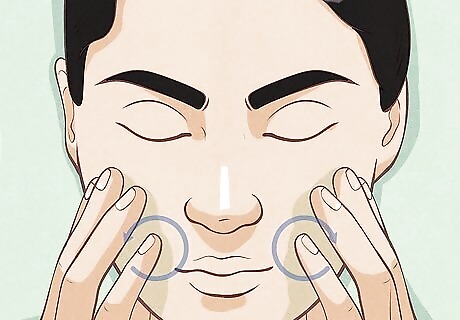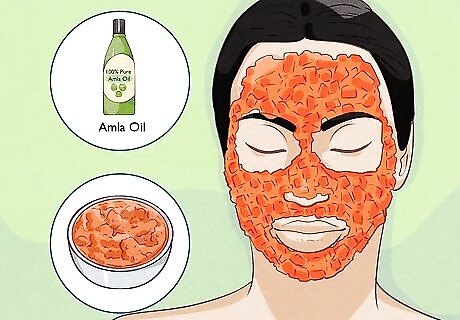
views
X
Trustworthy Source
PubMed Central
Journal archive from the U.S. National Institutes of Health
Go to source
You can apply the oil to your hair or skin as a moisturizing treatment or leave it on overnight.
Conditioning Your Hair with Amla Oil

Choose organic, cold-pressed plant oil, if possible. Look to online stores or specialty markets to find 100% pure amla oil. Don't forget to check the ingredients list to make sure there are no dyes, fragrances, preservatives, and other additives (especially if you’re allergic or have a sensitive scalp). You can buy amla in powder form as well, if you like. You'll have to make a paste out of it by adding ⁄4 cup (59 mL) of water for every 1/2 cup (64 grams) of amla powder before applying it to your hair.

Do a spot test to check for any signs of an allergic reaction. Pour a dime-sized amount of amla oil onto your inner forearm or wrist. Then, wait 24 hours to see if you experience a rash or any redness. If you have a reaction, don’t use the amla oil. If nothing happens, it’s safe to use on your scalp. If you do have a reaction, note that it could also be from any base oils in the blend like coconut, jojoba, or argan oil. Check the ingredients list if you have known allergies or reactions to oil-based products in the past.

Dampen your hair and part it down the middle. Spritz your hair with water and comb it through until all of it is adequately damp. Then, use your fingers or a comb to part your hair down the middle. Moisture raises the outer cuticle layer of the hair, allowing the oil to soak in deeper in a shorter period of time, so it’s best to apply it to damp hair. If you’ve already shampooed your hair in the shower, step out and apply the amla oil in place of your usual conditioner.

Massage your scalp with about ⁄4 cup (59 mL) of amla oil. Pour about ⁄4 cup (59 mL) of amla oil into your palm and carefully pour it onto your scalp. Use your fingers to massage it in, running it down the length of your hair. It’s normal to feel a slight cooling effect from the oil.

Use a palm full of oil on each section of your hair until it’s soaked. Pour more amla oil into your palm and massage it into front, sides, sides, and back of your hair until all the strands have been covered. If you have areas where your scalp is dry, itchy, or balding, apply a little extra to those parts. Make sure to coat the tips of your hair, especially if your hair is dried out and prone to split ends.

Wrap your hair in a warm towel for 15 minutes. Warm up a towel by putting it in the dryer on high heat for a few minutes. Then, wrap your oiled hair with the towel and let it sit for 15 minutes. This will help the oil soak into your strands and scalp. You can also dampen a towel with hot water and then wrap your hair with it. Certain blends of amla oil call for leaving it on for up to 2 hours, so refer to the instructions on the bottle.

Rinse your hair thoroughly with warm water until all of the oil is out. Rinse the hair out with just warm water if you’re using amla oil in place of your conditioner. Use your normal shampoo and conditioner to rinse the oil away if you’re using the oil as a moisturizing treatment on previously soiled hair. The oil is gone when you squeeze water out of your hair and don’t see any translucent swirls in the water. If you have dry or frizzy hair, use sulfate-free shampoo and conditioner to retain your hair’s natural oils.

Condition your hair with amla oil 1 or 2 times per week for 16 weeks. If you’re trying to grow your hair out or repair dry, damaged hair, do an amla oil treatment once or twice a week. You can use it more often if you’d like, just note that your hair might appear oily and you might give off a particularly pungent scent! It may take about 16 weeks before you notice an improvement. You can also do a mini-application between washes to tame frizz by rubbing a quarter-sized amount onto your hands and running your fingers through the tips of your hair.
Using the Oil as an Overnight Hair and Scalp Treatment

Part your dry hair down the middle with your fingers or a comb. Parting your hair will make it easier to apply the oil to each section (the sides and back). It will also help the oil concentrate at the top of your scalp, an area more prone to dryness and itching. If you have a particular area of your scalp that is dry or flaky, part your hair so that part is exposed and you can focus the oil in that area.

Pour ⁄4 cup (59 mL) of amla oil into your palm and massage your scalp. Cup your hand and pour as much amla oil into your palm as you can hold, which will probably be around ⁄4 cup (59 mL). Then, pour it into your scalp and let the oil soak into the roots of your hair. If the amla oil came in a squeeze bottle, feel free to squeeze it onto your hair instead.

Apply more oil until each strand becomes dampened with amla oil. Keep applying the oil until every strand is soaked from root to tip. If you have curly hair, it may help to comb it through with a wide-toothed comb. Apply extra oil in areas that are particularly dry, itchy, or balding (like the roots near the crown of your head or the tips of your hair).

Bunch your hair up and cover it with a shower cap. Use clips or loose elastic bands to bunch your hair up. Then, cover your head in a shower cap to protect your pillowcase and sheets from getting oily. The shower cap will also help retain heat coming from your head overnight, which will help open the hair follicles so the oil can soak in better.

Rinse your hair with warm water, shampoo, and conditioner in the morning. Once you wake up, rinse the oil out of your hair with warm water until there’s no sign of the oil left in your hair. Then, apply your usual shampoo and conditioner. Let your hair get saturated with water and squeeze a little out into your palm to see if you notice any translucent swirls in the water. If there are none, continue with your regular hair washing routine.
Applying Amla to Your Skin

Use a few drops of amla oil to moisturize and tone the skin on your face. Wash away dirt and makeup with your usual cleanser then deposit 3 to 5 drops of amla oil onto your palms. Rub your hands together and work the oil into your skin, massaging your face upward and outward from your nose. Be careful not to get the oil in your eyes because it will sting!

Make a sugar scrub with amla oil to remove dead skin. Create an exfoliant by mixing 1 cup (240 mL) of amla oil with 1/2 cup (64 grams) of sugar and 2 tablespoons (30 mL) of rose water. Gently rub the mixture onto your face or body, then wash it off with warm water and pat your skin dry. Avoid exfoliating on areas with open wounds, sores, or acne lesions because this may increase irritation and redness. Don’t harshly scrub your skin, especially the sensitive skin on your face! Do this treatment once or twice a week to keep your skin fresh and glowing.

Massage pure amla oil onto your skin as an anti-aging treatment. Take a spa day for yourself and massage your face and body with a liberal amount of amla oil so that your skin is fully soaked. Do this either before or after you shower. If you choose to leave it on throughout the day, make sure you’re okay with the smell! Make sure to cover all of the areas that are prone to wrinkles, discoloration, or other signs of aging that you might be concerned about. Amla promotes the production of procollagen, a precursor to collagen to maintain healthy skin tissue, shrink pores, and repair damage.

Treat dry, flaky skin with an overnight application. If you have dry patches of skin on your elbows, feet, arms, or back, rub amla oil onto your skin before going to bed. Use about 1 or 2 quarter-sized amounts of amla oil on each section of your skin. If you’re putting it on your feet, wear socks to avoid slipping when you get up during the night or in the morning.

Soothe and even your skin tone with an amla and papaya facial mask. Combine 1 tablespoon (15 mL) of amla oil and 2 tablespoons (30 grams) of mashed papaya and dab or smear it onto your face. Let it sit for 15 minutes and then wash your face with cool water. If you have fresh amla fruit, use 2 tablespoons (30 mL) of the juice along with 2 tablespoons (30 grams) of mashed papaya. Do this treatment every other day to ease redness and correct discoloration on your face.













Comments
0 comment